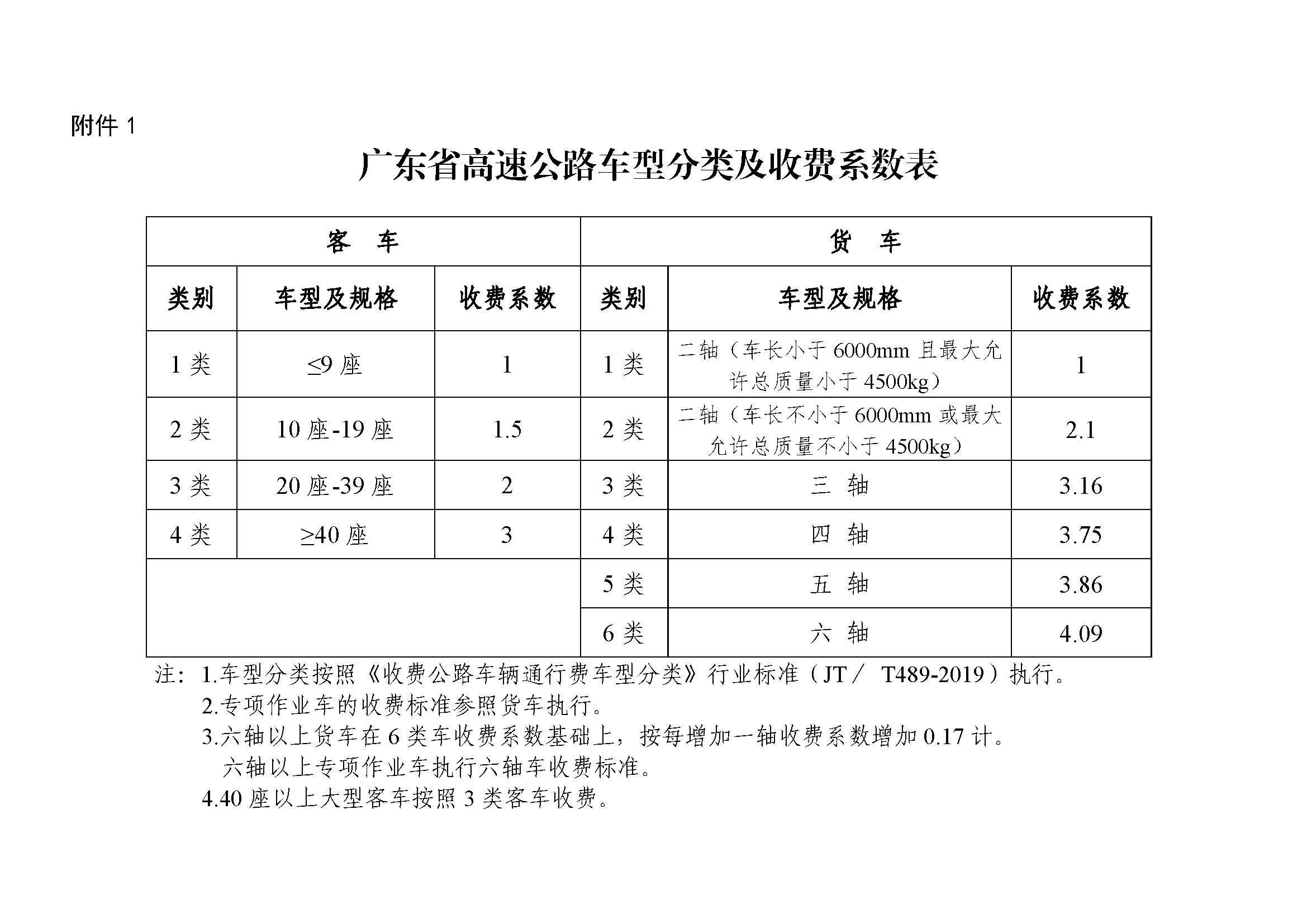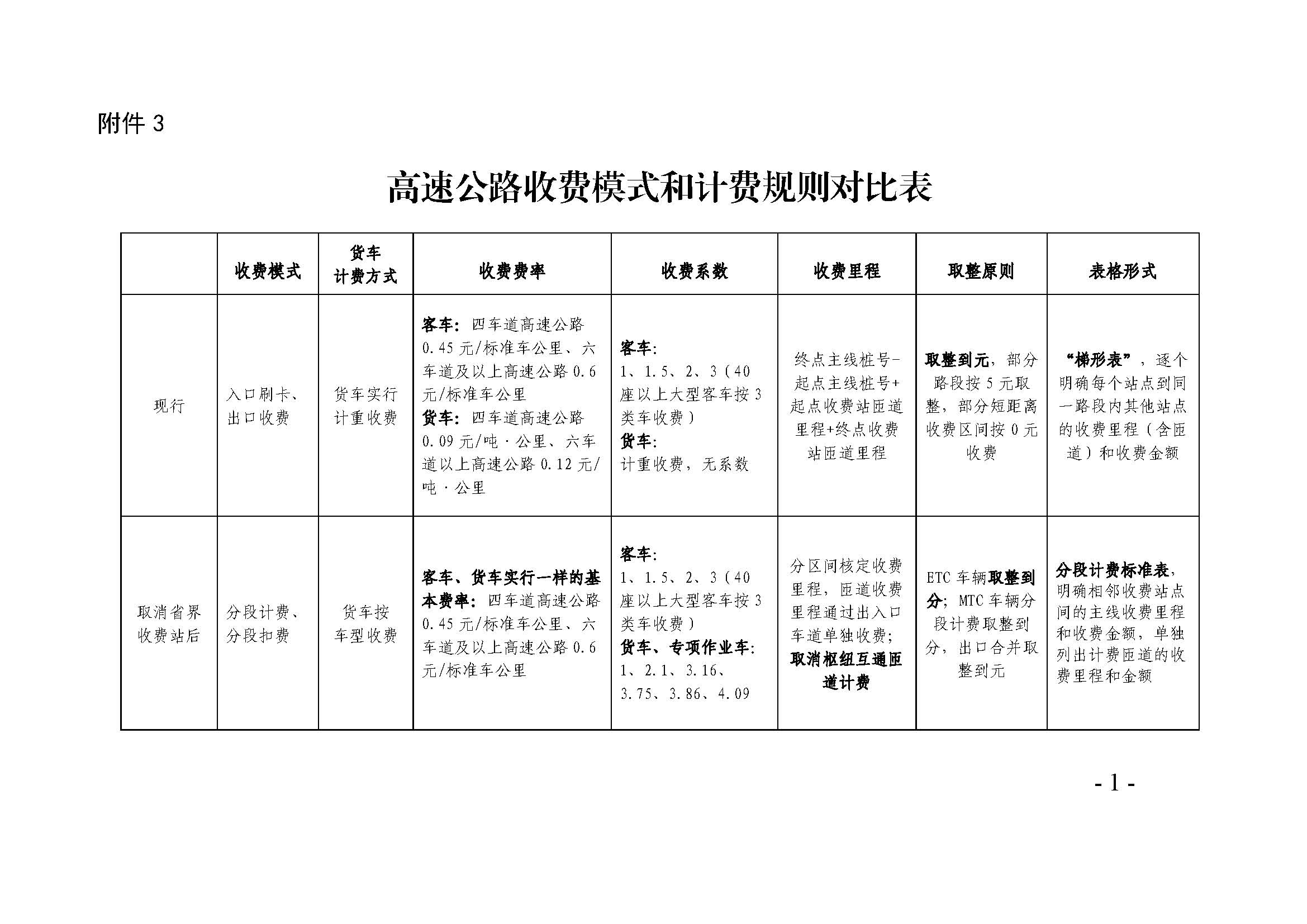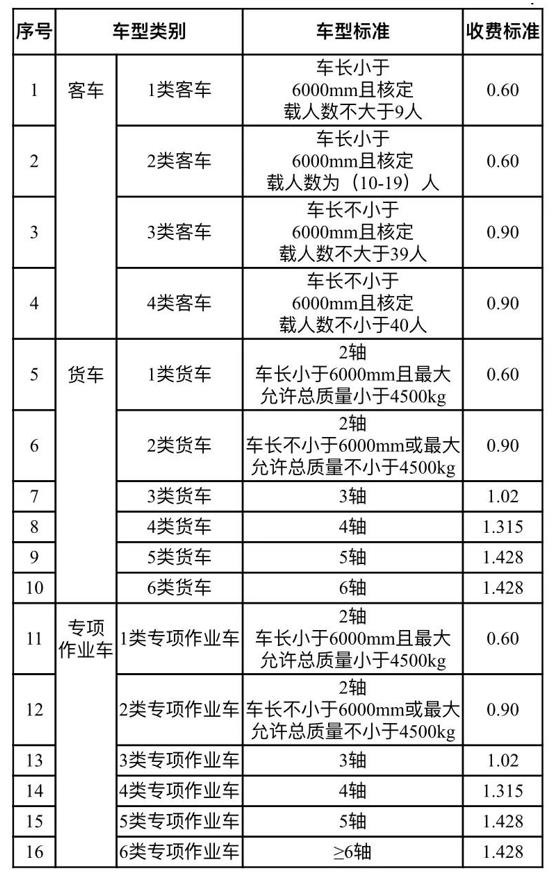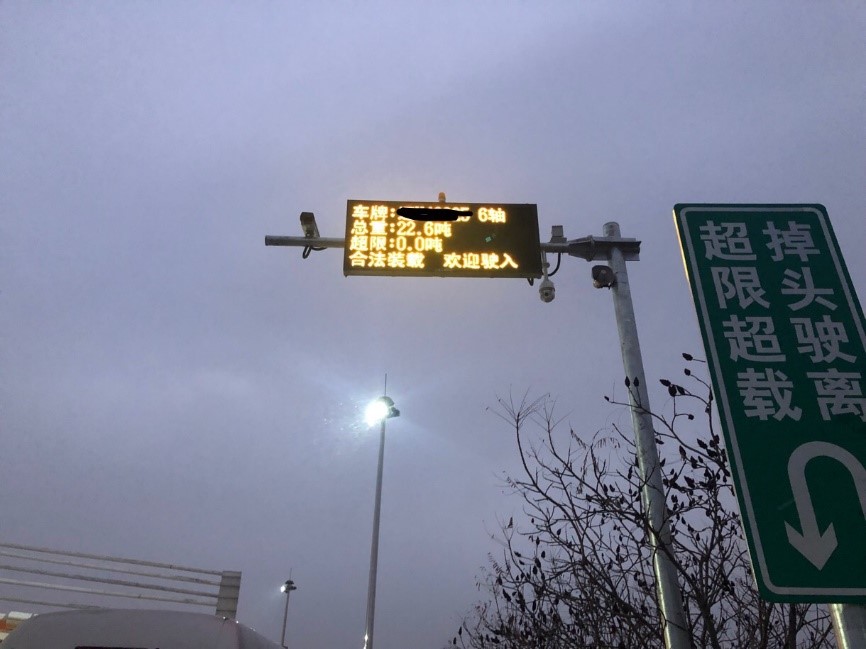Four focuses of expressway toll collection: new changes in the classification of passenger cars, and obvious price increase of freight cars with no load.
Since January 1st, the new expressway toll system in China has been officially put into operation, which also means that all provinces and cities have begun to implement the new expressway toll standard. Starting this year, all the passenger cars and vehicles with 8 passengers and 9 passengers have reduced the charging standards of the corresponding vehicles; At the same time, due to accurate charging, truck charging by axle and other reasons, the highway tolls of some vehicles will increase.
The Ministry of Communications said that all localities will follow the principle of "two guarantees" when organizing the adjustment and calculation of truck tolls, that is, under the same traffic flow conditions, ensure that the overall burden of truck tolls will not be increased; Ensure that the toll payable for each type of toll vehicle under the standard loading state is not greater than the toll payable for the original toll by weight.
Recently, Beijing, Shanghai, Shandong, Guangdong and other places have issued and implemented new highway toll standards. The reporter from www.thepaper.cn, The Paper, found that compared with before, a big change is that from January 1, 2020, 8-seat and 9-seat minibuses with a length of less than 6 meters will be uniformly charged according to Class I buses. In the previous vehicle classification, the classification limit value of Class 1 and Class 2 buses was 7 passengers.
Taking Guangdong Province as an example, the new charging standard shows that for the 8-seat and 9-seat minibuses that meet the requirements, the vehicle tolls will be uniformly charged according to Class 1 buses from the New Year, and the charging standard will be reduced by 1/3. At the same time, Guangdong province still charges for large buses with more than 40 seats according to the three types of buses, and the charging standard is reduced by 1/3.

Guangdong Province Expressway Vehicle Classification and Toll Coefficient Table

Comparison table of expressway charging mode and charging rules
Another recent change in the new standards of high-speed toll collection in various places is that trucks will be charged according to the type of vehicle (axle) and the non-stop weighing inspection at the entrance of closed expressway toll stations will be implemented simultaneously.
In this regard, The Paper reporter learned that the change of highway toll since the New Year has a great impact on empty or light trucks. Especially for the freight transportation that must take the expressway, this affects the profit space of freight companies to a certain extent, but it also forces related enterprises to increase the actual load rate and enjoy the policy dividend of adjusting the charging method without overloading.
Focus 1: New changes in the classification of bus models
In May 2019, the Ministry of Communications issued the newly revised Classification of Toll Vehicles on Toll Roads, which clarified that the classification limit value of Class 1 and Class 2 passenger cars was revised from 7 approved passengers to 9 passengers. This means that since the implementation of the standard revision on January 1 this year, the number of passenger cars with 8 passengers and 9 passengers has been reduced from the original class 2 passenger cars to class 1 passenger cars, which has reduced the charging standard of the corresponding vehicles.
Li Aimin, vice president of the Highway Science Research Institute of the Ministry of Transport, said that if 8-seat and 9-seat minibuses are collected as Class I buses, the charging standard will be reduced by 1/3 to 1/2 on average, and the toll burden of these vehicles will be significantly reduced. In addition, some provinces charge buses for downshifting, for example, the second-class buses in Shanghai are charged according to the first-class buses, which will also reduce the highway toll standards of some buses.

Under the new standard, Shanghai will charge the bus for downshifting, and the second-class bus will be charged according to the first-class bus.
It is worth noting that in recent days, many places have also released relevant information to update the information of ETC (Electronic Non-stop Toll Collection System) of 8-seat and 9-seat minibuses. For example, Zhejiang ETC Center has recalled and updated the vehicle information of ETC users of 8-seat and 9-seat minibuses since December 25, 2019, and re-approved the models of vehicles that meet the requirements.
The relevant person in charge of the Road Network Management Office of the Highway Bureau of the Ministry of Communications told the reporter of The Paper (www.thepaper.cn) that the 8-seat and 9-seat minibuses that have not updated ETC information need to update ETC information, so that they can be charged according to Class I buses.
The person in charge said that as early as July 16, 2019, the Ministry of Transport issued a notice on issues related to the implementation of the industry standard "Classification of Toll Vehicles on Toll Roads" (JT/T 489—2019), clarifying that from January 1, 2020, 8-seat and 9-seat minibuses with a vehicle length of less than 6 meters will be uniformly charged according to Class I buses, and ETC on-board devices will be installed or replaced or vehicle classification will be adjusted.
Focus 2: Does accurate charging bring about an increase in tolls?
According to the Ministry of Transport, starting from January 1st this year, the rules of starting price in 5 yuan and one billing unit in 5 yuan will no longer be implemented for expressway tolls. The single transaction amount of ETC vehicles will be rounded to the nearest minute, and the single transaction amount of MTC vehicles will be rounded to the nearest yuan according to the rounding rule, and the corresponding fees will also "rise and fall".
Recently, the high-speed toll of passenger cars from Qingdao East Railway Station to Qingdao Airport Station has risen from 5 yuan to 8 yuan, and the high-speed toll of taxis from Shanghai to Changxing Island has all been related to this.
For example, from Qingdao East Station to Liuting International Airport via Qingdao section of Qingyin Expressway, the charging mileage between the two stations is 19.85 kilometers. Take a class I bus (with 9 seats or less) passing through this section as an example. The benchmark rate is 0.4 yuan/km, and the calculation method according to the original standard is: 0.4×19.85=7.94 yuan. According to the principle of "two homes, eight cars, three seven for five", the fees for manual and ETC vehicles are all 5 yuan after rounding.
After the implementation of accurate route billing on January 1 this year, after the first-class passenger cars that normally use ETC enjoy preferential rates, the accumulated toll amount after three portal concessions is 4.99 yuan/train, which is consistent with the previous original standard; Vehicles driving in artificial lanes should be rounded to the nearest yuan, and then they should be collected from 8 yuan.
In addition, the change brought by the accurate charging of ETC portal frame segments is that after the provincial toll station of expressway is cancelled, each ETC portal frame is responsible for charging the fees of its section, that is to say, how many roads to take and how much to pay.
Therefore, the toll of vehicles that walk a long section between two points will increase compared with the toll charged according to the shortest path before. Li Aimin said that compared with the original charging system, the accurate charging of portal frame sections is more accurate, more fair and reasonable.
Gu Zhifeng, director of the Road Network Management Office of the Highway Bureau of the Ministry of Transport, said earlier that, for example, driving from Baoding, Hebei Province to Shijiazhuang, the toll was only calculated according to the distance between the two places. However, if the driver detours to other places and then returns to Shijiazhuang, the whole journey will be charged, so the corresponding toll will be higher than before.
Focus 3: After charging by axle, the no-load price increase of freight cars is obvious.
In the classification of truck models, the newly revised classification standard adopted the total axle number of vehicles as the first index of truck model classification since January 1 this year, and simultaneously implemented non-stop weighing detection at the entrance of closed expressway toll stations.
According to the relevant departments of the Ministry of Transport, adopting the classification index according to the number of vehicle axles will fundamentally solve the problem of "large tons and small standards" of vehicles, which is conducive to standardizing the truck market and fair charging.
Li Yun, who is engaged in container cargo transportation at Yantian Port in Shenzhen, told The Paper (www.thepaper.cn) that the semi-trailer he was driving was installed with ETC at the end of 2019, and he usually engaged in the transportation of import and export goods in Guangdong Province.
Li Yun said that when he was driving a four-axle truck through the Humen Second Bridge Expressway, he had to pay 180 yuan for a one-way trip with no load for about 15 kilometers, while the one-way fare with full load was about 210 yuan; Now, after charging by axis, the one-way trip is about 200 yuan. "If you go back and forth, it will cost 10 yuan and 20 yuan."
As the bridge toll is a part of the freight company’s contracting cost, Li Yun thinks that the price increase of empty trucks will compress the freight company’s profits to some extent. At the same time, he said that in the case of "no hurry", most truck drivers will choose to take national highways and other low-speed highways. This new regulation will have a greater impact on freight companies with high timeliness requirements, such as express delivery companies.
The relevant person in charge of the Highway Bureau of the Ministry of Transport said earlier that under the condition of legal loading, vehicles of the same axle, whether empty or heavy, occupy basically the same highway resources, so it is reasonable to charge them the same standard toll.
At the same time, charging by car (axle) without distinguishing between heavy cars and empty cars can objectively encourage truck drivers to transport with full load on toll roads, so as to reduce the empty driving rate and save logistics and transportation costs.
Wu Dejin, director of the Highway Bureau of the Ministry of Communications, said that after canceling the provincial toll station and adjusting the high-speed charging method for trucks, the fees for empty trucks may increase. Wu Dejin suggested that relevant enterprises should strengthen transportation organization, and enjoy the policy dividend of adjusting the charging method by increasing the actual loading rate.
Focus 4: Why can’t the entrance weighing system continue to charge by weight?
At present, 11,401 sets of weighing detection systems have been implemented at the entrance of expressways. "Entrance weighing" means that once the trucks are overloaded and overrun, they will be directly persuaded not to go on the expressway.
On January 8th, Gao Zhao, deputy director of the Command and Dispatching Center of Liaoning Expressway Operation Company, told the reporter of The Paper (www.thepaper.cn) that the ultimate goal of carrying out truck expressway entrance weighing is to cooperate with the use of ETC, realize the "charging without stopping" of trucks during the whole journey of expressway, and achieve the goal of "lifting the pole and leaving" of trucks at the exit of expressway, thus improving the overall traffic efficiency.

Liaoning high-speed overrun detection system. The Paper reporter Zhang Ruoting
Gao Zhao said, at present, the entrance weighing system used in expressways can still accurately measure the weight of trucks, but this weight result is no longer used as the data for calculating tolls, but only as the basis for checking whether there is overweight.
According to the Ministry of Transport, the truck entrance weighing system realizes data networking. At the toll station, trucks will automatically lift the pole after being tested for legal compliance. For overloaded trucks, the automatic pole will not lift the pole and will not enter the high speed.
Previously, China’s expressways generally implemented truck export toll by weight, with the aim of curbing overloading through economic means. However, due to the need to stop and weigh by weight, the traffic efficiency of freight cars has been affected to some extent.

The information of trucks and vehicles is displayed on the big screen after passing through the expressway entrance weighing system. The Paper reporter Zhang Ruoting
In fact, as early as September 21, 2016, the revised Regulations on the Administration of Overloaded Transport Vehicles on Roads has clearly stated that weighing inspection should be carried out at the entrance of expressways. In April 2019, the Ministry of Transport issued the Notice on Further Standardizing the Overload Control of Expressway Entrance, which made it clear that by the end of 2020, all the entrances of closed expressway toll stations in China will have completed the construction of inspection facilities and equipment installation, and the entrance weighing inspection will be fully implemented. The average illegal overloading rate of expressway trucks in all provinces (autonomous regions and municipalities) will not exceed 0.5%.